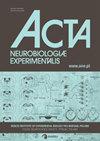Evaluation of neurogranin levels in a rat model of diffuse axonal injury
IF 1.4
4区 医学
Q4 NEUROSCIENCES
引用次数: 0
Abstract
Diffuse axonal injury (DAI), one of the most common and devastating type of traumatic brain injury, is the result of the shear force on axons due to severe rotational acceleration and deceleration. Neurogranin (NRGN) is a postsynaptic protein secreted by excitatory neurons, and synaptic dysfunction can alter extracellular NRGN levels. In this study, we examined NRGN levels in serum and cerebrospinal fluid (CSF) after experimental DAI in terms of their diagnostic value. Experimental DAI was induced using the Marmarou technique in male Wistar albino rats. Serum and CSF NRGN levels of the sham group, one‑hour, six‑hour, 24‑hour, and 72‑hour post‑DAI groups were measured by ELISA method. DAI was verified by staining with hematoxylin‑eosin and β‑amyloid precursor protein in the rat brain samples. While no histopathological and immunohistochemical changes were observed in the early hours of the post‑DAI groups, the staining of the β‑APP visibly increased over time, with positivity being most frequent and intense in the 72‑hour group. It was found that serum NRGN levels were significantly lower in the 6‑hour group than in the sham group. The serum NRGN levels in the 24‑hour group were significantly higher than those in the sham group. This study showed a dichotomy of post‑DAI serum NRGN levels in consecutive time periods. NRGN levels in CSF were higher in the one‑hour group than in the sham group and returned to baseline by 72 hours, although not significantly. Our study provides an impression of serum and CSF NRGN levels in a rat DAI model in consecutive time periods. Further studies are needed to understand the diagnostic value of NRGN.评估弥漫性轴突损伤大鼠模型中的神经粒蛋白水平
弥漫性轴索损伤(DAI)是最常见、最具破坏性的脑外伤类型之一,是轴索在剧烈旋转加速和减速过程中受到剪切力的结果。神经粒蛋白(NRGN)是兴奋性神经元分泌的突触后蛋白,突触功能障碍可改变细胞外 NRGN 的水平。本研究考察了实验性 DAI 后血清和脑脊液(CSF)中 NRGN 水平的诊断价值。实验性 DAI 采用 Marmarou 技术诱导雄性 Wistar 白化大鼠。采用 ELISA 方法测定假组、DAI 后 1 小时组、6 小时组、24 小时组和 72 小时组的血清和脑脊液 NRGN 水平。用苏木精-伊红和β-淀粉样前体蛋白对大鼠脑样本进行染色,以验证DAI。虽然在DAI后各组早期未观察到组织病理学和免疫组化变化,但随着时间的推移,β-APP的染色明显增加,其中72小时组的阳性率最高,强度最大。研究发现,6 小时组的血清 NRGN 水平明显低于假组。24 小时组的血清 NRGN 水平明显高于假体组。这项研究显示,DAI 后血清 NRGN 水平在连续时间段内呈现出两极分化。一小时组脑脊液中的 NRGN 水平高于假体组,72 小时后恢复到基线水平,但恢复不明显。我们的研究提供了大鼠 DAI 模型在连续时间段内血清和脑脊液中 NRGN 水平的印象。要了解 NRGN 的诊断价值,还需要进一步的研究。
本文章由计算机程序翻译,如有差异,请以英文原文为准。
求助全文
约1分钟内获得全文
求助全文
来源期刊
CiteScore
2.20
自引率
7.10%
发文量
40
审稿时长
>12 weeks
期刊介绍:
Acta Neurobiologiae Experimentalis (ISSN: 0065-1400 (print), eISSN: 1689-0035) covers all aspects of neuroscience, from molecular and cellular neurobiology of the nervous system, through cellular and systems electrophysiology, brain imaging, functional and comparative neuroanatomy, development and evolution of the nervous system, behavior and neuropsychology to brain aging and pathology, including neuroinformatics and modeling.

 求助内容:
求助内容: 应助结果提醒方式:
应助结果提醒方式:


